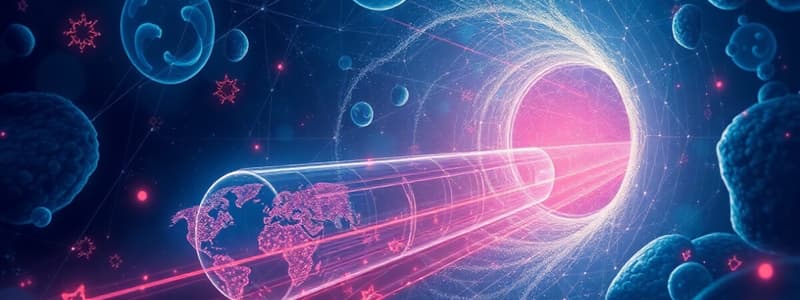Podcast
Questions and Answers
Homeostasis is maintained by the cell ______ controlling the movement of things in and out of the cell.
Homeostasis is maintained by the cell ______ controlling the movement of things in and out of the cell.
membrane
Passive Transport requires no extra ______ by the cell because molecules move from high concentration to low concentration.
Passive Transport requires no extra ______ by the cell because molecules move from high concentration to low concentration.
energy
The process of spreading out molecules across a membrane until ______ is reached.
The process of spreading out molecules across a membrane until ______ is reached.
equilibrium
Active Transport requires extra energy (ATP) to move materials from ______ to high concentration against the concentration gradient.
Active Transport requires extra energy (ATP) to move materials from ______ to high concentration against the concentration gradient.
A ______ is a uniform mixture of two or more substances.
A ______ is a uniform mixture of two or more substances.
Facilitated diffusion involves a transport ______ that helps molecules pass through the cell membrane.
Facilitated diffusion involves a transport ______ that helps molecules pass through the cell membrane.
Things that are small, nonpolar, and hydrophobic can easily pass through the cell ______.
Things that are small, nonpolar, and hydrophobic can easily pass through the cell ______.
Examples of molecules that use facilitated diffusion include ______ and polar molecules like calcium.
Examples of molecules that use facilitated diffusion include ______ and polar molecules like calcium.
The simple diffusion of water across the cell membrane is known as ______.
The simple diffusion of water across the cell membrane is known as ______.
Low water concentration means ______ solute concentration.
Low water concentration means ______ solute concentration.
Flashcards
Selectively Permeable Membrane
Selectively Permeable Membrane
The cell membrane is selectively permeable, meaning it only allows certain substances to pass through.
Passive Transport
Passive Transport
Movement of molecules from an area of high concentration to an area of low concentration, requiring no energy from the cell.
Active Transport
Active Transport
Movement of molecules from an area of low concentration to an area of high concentration, requiring energy from the cell.
Solute
Solute
Signup and view all the flashcards
Solvent
Solvent
Signup and view all the flashcards
Simple Diffusion
Simple Diffusion
Signup and view all the flashcards
Transport Protein
Transport Protein
Signup and view all the flashcards
Osmosis
Osmosis
Signup and view all the flashcards
Hypotonic Solution
Hypotonic Solution
Signup and view all the flashcards
Hypertonic Solution
Hypertonic Solution
Signup and view all the flashcards
Study Notes
Cell Transport Concept 2 Notes
- Cell transport is essential for maintaining homeostasis at the cellular level.
- The cell membrane controls what enters and exits the cell.
- The membrane is selectively permeable, meaning it is picky about what passes through.
- Small, nonpolar molecules and water can easily pass through.
- Polar molecules and larger molecules cannot easily pass through.
- Transport of materials across the membrane is either passive or active.
Passive Transport
- Passive transport does not require energy input.
- Molecules move from an area of high concentration to an area of low concentration (down the concentration gradient).
- Includes simple diffusion, facilitated diffusion, and osmosis.
Simple Diffusion
- The movement of small, nonpolar molecules across a membrane.
- Example: Oxygen (O2) and carbon dioxide (CO2).
- Molecules move to equalize concentration across the membrane until equilibrium is reached.
Facilitated Diffusion
- The movement of large molecules or polar molecules with the assistance of protein channels.
- Examples: Glucose (sugar = C6H12O6).
- Larger or polar substances cannot easily pass through the membrane, but proteins aid the movement.
Osmosis
- The diffusion of water across a membrane.
- Water moves from a high water concentration to a low water concentration.
- Water concentration is inversely related to solute concentration. High water means low solute; low water means high solute.
- The movement of water affects the shape and function of cells.
- Solutions can be hypertonic (lower water concentration than the cell), hypotonic (higher water concentration than the cell), or isotonic (equal water concentration to the cell).
- In hypertonic solutions, water moves out of the cell, causing the cell to shrivel.
- In hypotonic solutions, water moves into the cell, causing the cell to swell.
- In isotonic solutions, water movement is balanced, and the cell shape remains unchanged.
Active Transport
- Active transport requires energy input (ATP).
- Molecules move against the concentration gradient (from low to high concentration).
- Includes molecular pumps, exocytosis, and endocytosis.
Molecular Pumps
- Use energy to move molecules across the membrane.
- Examples: Potassium (K+), chlorine (Cl-), and sodium (Na+) ions.
- These ions are usually charged particles.
Exocytosis
- Exporting materials out of a cell.
- Example: Neurotransmitters released by nerve cells.
Endocytosis
- Importing large particles into a cell.
- Example: White blood cells engulfing bacteria.
Additional Information
- Solute is what gets dissolved. A good example is lemonade powder.
- Solvent is what dissolves. A good example is water.
- Solution is a mixture of both.
- Concentration is the amount of solute dissolved in the solvent and indicated by [ ].
- Cells use cell transport to maintain homeostasis.
Classroom Assignments & Activities
- Take cell tests and define terms from section 8.3.
- Complete assignments and activities related to cell transport over several days and weeks that include flashcards, reading, lab work and graphic organizers.
- Work on provided reading guides with related class time.
Studying That Suits You
Use AI to generate personalized quizzes and flashcards to suit your learning preferences.




